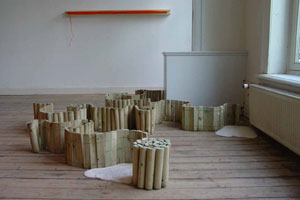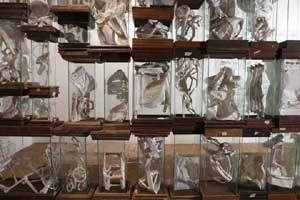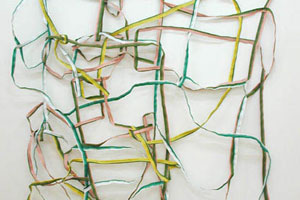Gerard Byrne: Hommes a Femmes (Michel Debrane)
Hommes a Femmes (Michel Debrane) (Men to Women [Michel Debrane])
2004
DVD still
Green on Red Gallery is pleased to present the Irish premiere of Homme à Femmes (Michel Debrane), a video project by Irish artist Gerard Byrne. This will be Byrne's third solo exhibition at the gallery.
Homme à Femmes (Michel Debrane) is a single channel video projection, which documents an attempt to dramatically re-enact a 1977 interview conducted between the French intellectual Jean-Paul Sartre, and journalist Catherine Chaîne, which was published in 'Le Nouvel Observateur' journal. The project develops from a number of previous projects Byrne has realised, each of which similarly engage a collective amnesia about our shifting cultural history, through dramatic re-enactments of culturally loaded conversations and interviews gleaned from discarded popular magazines. Previous works have delved into the forlorn double page spreads of issues from 'National Geographic' and 'Playboy' during the seventies and eighties; with Homme à Femmes (Michel Debrane) Byrne focuses on a generically candid encounter with Sartre, which discusses his relationship with women throughout his life, at a moment towards the end of that life.
In the original exchange Sartre, the emblematic European intellectual of the twentieth century, embodies a whole modernist patrimony under the scrutiny of a younger feminist journalist. In Byrne's project, a journeyman French actor (real name Michel Debrane) struggles to re-construct that edifice under the gaze of a camera, while being questioned from off-screen by an actress who plays the journalist Chaîne. Separated by age, and by gender, and formed by different epochs, Sartre a Marxist Modernist, and Chaîne a post '68 feminist, the schism between the two is dramatised in Byrne¹s project through the use of surround sound technology. In Homme à Femmes (Michel Debrane), Sartre never escapes the gaze of the camera, his alienated voice emanating from within the rectangular image. The voice of Chaîne emerges from outside and at odds with that projected image, from somewhere behind the viewer, mingling with both the noisy presence of the film crew in the space behind the camera, and the actual noise of viewers in the space of the gallery. The formal rupture between audio and image within the work, mirrors both the profound historical differences between the conversants, and the gap cleaved by the camera between those before it - Debrane, isolated in his struggle to personify Sartre, and those who stand behind and watch.
Homme à Femmes (Michel Debrane) was commissioned by BAK (Basis voor Actuele Aunst, Utrecht) and was co-commissioned and produced by Anna Sanders Films, Paris in 2004
Gerard Byrne has recently had solo exhibitions at Project, Dublin, BAK, Utrecht, both 2004, Frankfurter Kunstverein, Frankfurt, 2003, and at the Douglas Hyde Gallery, Dublin, 2002. He has participated in group shows at Kiasma, Helsinki, the Istanbul Biennale, the Whitney Museum of American Art, New York, and FRAC, Nord Pas-de-Calais, all 2003, and at Manifesta 4, Frankfurt, 2002. A monograph Books, magazines, and newspapers with a critical essay by George Baker, Assistant Professor of Art History at UCLA, was recently published by Lukas & Sternberg, New York.
![Hommes a Femmes (Michel Debrane) (Men to Women [Michel Debrane]) 2004 DVD still](https://images.squarespace-cdn.com/content/v1/5bf3e614b98a78ef0cabecbd/1543760696069-WFV9FERYGXPNTCV4R2ZL/GB_2.jpg)






